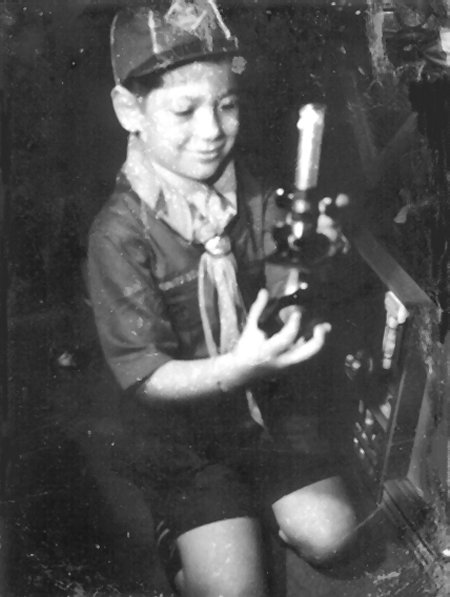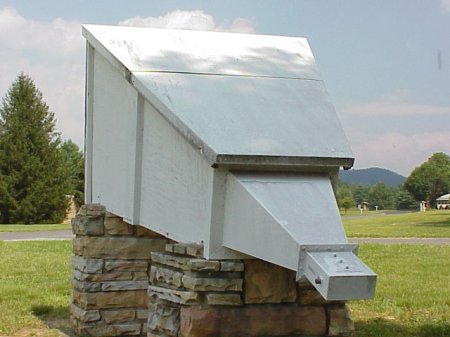
|
|
email Dr. SETI ® |
|
Occam's Rusty Blades
Copyright © 2001 by H. Paul Shuch, Ph.D.
Excerpted from Tune In The Universe! (ARRL)

|
|
email Dr. SETI ® |
|
I didn't always search for signals from the stars. There was a time when I would have been happy to receive a signal from right next door. At the age of eight, just a few years before Sputnik, I got it in my head to build a crystal radio. I had seen a World War II movie in which American prisoners of war had built their own crystal set out of available materials, in order to hear the news from the front. This seemed to me far more exciting than playing war games with the other boys on the block. When they chose up sides, and asked me what I wanted to be, I enthusiastically replied "a captured GI!"
I found a set of plans in one of my Cub Scout books, and it looked simple enough -- all I needed was an inductor (a coil of wire), a capacitor, an earphone, and a diode. Couldn't be simpler, I figured. Boy, did I get a wrong number!
 |
The coil, a couple of hundred turns of doorbell wire wound on a cylindrical oatmeal box, was the easy part. I wound the wire in a single layer, laid the assembly on its side, thumb-tacked it in place on a piece of plywood, and sanded off the enamel insulation along an arc on the top. I managed to fashion a slider out of a ball point pen refill, and thumb-tacked it down as well, getting only a little of the blue ink on my hands and clothes in the process. I now had what would pass as a variable inductor. (Thirty years later, when I tried to help my own eight-year-old son duplicate the project, the oatmeal was instant, mixed with water and heated in the microwave oven, and only to be found in envelopes sold in rectangular boxes. And by then the ball-point pen inserts were all plastic. And so I learned Lesson One: technological progress has its price.) |
Our war was pretty well structured. Because many of our fathers had fought in the Pacific, our games always pitted the GIs against the Japs. None of us knew exactly what a Jap was. We had a Japanese kid on the block who was treated pretty much like everyone else. When we chose up sides, it was "Yoji, you can be a Jap."
"No, I was a Jap last time. The Japs always lose. I want to be a GI."
And so he was.
For a capacitor I sandwiched a wax-paper dielectric between two sheets of tin foil. This I wound into a cylinder using a wooden pencil as a mandrel, taking care not to let the foil sheets touch. It took two or three tries before I figured out that the wax paper should be cut slightly wider than the foil. My only prior experience with this was the roll-up hors-d'oeuvres which my mother used to make before a party. There, the problem was the opposite: we couldn't let the cream cheese extend beyond the bread.
I read somewhere that the coil and capacitor together would form something called a tuned circuit, which would determine which radio station I would receive. Since the coil was variable (courtesy of the ball-point slider), the value of the capacitor was not particularly critical. Still, I had to have enough surface area to store sufficient charge. I must have rolled a dozen sandwiches before I got it right. Years later, I did a rough calculation of the result. I figured I had ended up with on the order of a hundred micro-micro-Farads (the unit is called picoFarads today). Since commercial AM radios use variable tuning capacitors spanning 50 to 365 pF, I wasn't really too far off the mark.
By the time I built the crystal radio with my son, tin foil had given way to aluminum, and wax paper was pretty much supplanted by Saran wrap. So we opted to go with a commercial dipped silver mica capacitor. But in my own youth, such costly components were not an option. I would come to regret my lack of access to commercial components shortly, when I tried to solder to my tin foil cap.
Headphones were ubiquitous. One simply used the ear-piece from a telephone handset. These were traded freely within my Cub Scout pack. It never occurred to me at the time to associate the ready supply of earphones with the dearth of handsets to be found in the local pay telephone booths.
Around this time, the character of our war games began to change. Somewhere along the line the Japs had disappeared, and we found ourselves playing out the GIs against the Commies. None of us knew exactly what a Commie was then -- any more than we do now. I asked an older kid, who said "they're kind of like Japs, only different." But he was playing a GI, so it hardly mattered to him. In truth, it wasn't important to any of us who the enemy was, only that we had one. I sometimes wonder if that's not how it works in the real world.
Now I needed a crystal diode. One popular approach was to use a galena quartz rock with a fine-wire "cat's whisker", but that was old technology. This was the Fifties, a modern era of transistors and other scientific marvels. (Even then, we had difficulty differentiating between science and technology.) Germanium point-contact diodes were all the rage, and they could be found in any of a number of army surplus electronic stores, for about ten cents apiece. But ten cents did not come easily to an eight-year-old in suburban Miami, so I decided to try another way.
In that old war movie, the prisoners had made their diode out of a rusty razor blade and a safety pin. They were shown moving the point of the pin along the rust spots of the blade, until they suddenly tuned in Tokyo Rose. I now understand how a junction of dissimilar metals can rectify, and that corrosion can help the process along. But at the time this seemed like a Hollywood contrivance. Nevertheless, I was willing to give it a try. My father provided the used double-edged razor blade, my mother's sewing kit yielded the safety pin with which to probe the blade for hot spots, and a couple of additional thumb tacks fastened the works down to the same plywood chassis which supported the coil. Only, when the receiver was wired up, there was nothing to be heard.
It occurred to me that the razor blade wasn't rusty enough. I asked my father about this. He took great pride in using the newest, stainless steel blades, and never did understand the nature of my problem. Lesson Two: one man's beauty is another man's bane.
I had no choice but to save up my allowance for one of those war-surplus diodes. It was a thing of beauty, not only because it had cost ten cents, but also because of its construction. Unlike the axial-lead glass diode packages of today, this was a white ceramic cylinder about five millimeters wide, with gold end-caps, one the diameter of a pencil eraser, the other the size of the pencil lead. I didn't know a cathode from an anode then, but fortunately, in the crystal radio polarity didn't matter.
At just about this time, the same kind of diode was being used as a mixer by Harold Ewen and Edward Purcell to receive the microwave radiation from interstellar hydrogen. Hydrogen is the most abundant substance in interstellar space, averaging about one atom per cubic centimeter. It emits a distinct radio signature at 1420 MHz, and this is the signal Ewen and Purcell detected with a waveguide horn antenna from the rooftop of a Harvard University lab building. Their discovery is memorialized in song.
Here's a picture of the very horn antenna Ewen and Purcell used to make that astounding first detection of the hydrogen line. The antenna now resides at the National Radio Astronomy Observatory, in Green Bank WV. The diode is still inside the waveguide mixer, seen at the lower right. But I digress.

For their discovery, Ewen received his PhD, plus the distinction of writing the shortest Physics dissertation on record, a scant dozen pages. (Later, I produced over 200 pages for my own Doctorate. I suppose if I had actually discovered something, I wouldn't have had to write so much.) Purcell, Ewen's professor, was ultimately awarded the Nobel Prize. For my part, I had no concept of, nor interest in, signals from space. That would come later. Now, I was hoping just to hear the truck driver from Tupelo sing "That's Alright, Mama." But first I had to master soldering.
The directions in the Cub Scout book were quite specific: once the components were laid out, the interconnecting wires would have to be soldered together. Since I had never even seen a soldering iron, I turned to the source of all knowledge -- my father. "Joe down the street is an automobile mechanic," he offered. "I'll bet he has a soldering iron."
Sure enough, Joe did, and he was more than happy to lend it to me. A terrifying instrument about half a meter long, it consisted of a huge iron poker set in a massive wooden handle. He used it for sealing leaky radiators, and it was heated by holding the tip in the flame of a propane torch. Since we had a natural gas stove, bringing the implement of torture up to temperature in the blue burner flame was no particular problem. The molten mass it made of my tin foil was. But that didn't hold a candle to the excitement which followed, as my wax paper dielectric burst into flame. And so I learned the meaning of rework at an early age. The experience prepared me well for the rigors which were to follow, during my career as an aerospace engineer.
Second time around, I managed to solder my capacitor without resembling a Fourth of July celebration. Lesson Three: it doesn't take a rocket scientist.
At last I had my crystal radio working, and was ready to join the neighborhood boys in war games. "What do you want to be, Howie," one of them asked, "a GI or a Commie?" (This was a dozen years before I started going by my middle name. Today, the only person allowed to call me Howard is my mother.) A captured GI, I replied.
"Why? So you can escape?" I was positively dumbstruck. The thought had never even occurred to me!

|
Copyright © H. Paul Shuch, Ph.D.; Maintained by Microcomm this page last updated 14 June 2007 |
TOP |